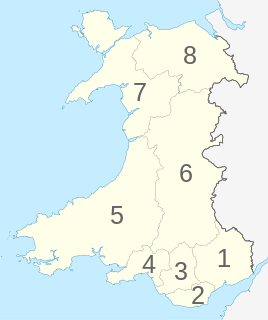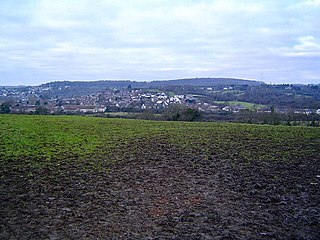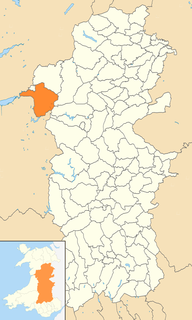
Powys is a principal area and county, and one of the preserved counties of Wales. It is named after the Kingdom of Powys which was a Welsh successor state, petty kingdom and principality that emerged during the Middle Ages following the end of Roman rule in Britain.

John Cowper Powys was a British philosopher, lecturer, novelist, literary critic, and poet, born in Shirley, Derbyshire, where his father was Vicar of St Michael and All Angels Parish Church in 1871–1879. Powys appeared with a volume of verse in 1896 and a first novel in 1915, but gained success only with his novel Wolf Solent in 1929. He has been seen as a successor to Thomas Hardy, and Wolf Solent, A Glastonbury Romance (1932), Weymouth Sands (1934), and Maiden Castle (1936) have been called his Wessex novels. As with Hardy landscape is important. So is elemental philosophy in his characters' lives. In 1934 he published an autobiography. Powys had success as an itinerant lecturer, in England, and in 1905–1930 in the US, where he wrote many of his novels and had several first published. He moved to Dorset, England, in 1934 with his American partner, Phyllis Playter. In 1935 they moved to Corwen, Merionethshire in Wales, where he set two novels, then in 1955 to Blaenau Ffestiniog, where he died in 1963.

Montgomeryshire, also known as Maldwyn is one of thirteen historic counties and a former administrative county of Wales. It is named after its county town, Montgomery, which in turn is named after one of William the Conqueror's main counsellors, Roger de Montgomerie, who was the 1st Earl of Shrewsbury.

The preserved counties of Wales are the current areas used in Wales for the ceremonial purposes of lieutenancy and shrievalty. They are based on the counties created by the Local Government Act 1972 and used for local government and other purposes between 1974 and 1996.

Welshpool is a market town and community in Wales, historically in the county of Montgomeryshire, but currently administered as part of the unitary authority of Powys. The town is four miles from the Wales–England border and low-lying on the River Severn; its Welsh language name Y Trallwng means "the marshy or sinking land". The community includes Cloddiau and Pool Quay.

The Kingdom of Powys was a Welsh successor state, petty kingdom and principality that emerged during the Middle Ages following the end of Roman rule in Britain. It very roughly covered the northern two-thirds of the modern county of Powys and part of today's English West Midlands. More precisely, and based on the Romano-British tribal lands of the Ordovices in the west and the Cornovii in the east, its boundaries originally extended from the Cambrian Mountains in the west to include the modern West Midlands region of England in the east. The fertile river valleys of the Severn and Tern are found here, and this region is referred to in later Welsh literature as "the Paradise of Powys".
This is an incomplete list of people who have served as Lord Lieutenant for Powys. Prior to 1974, the Monarch was represented in the area by the Lord Lieutenant of Montgomeryshire, the Lord Lieutenant of Radnorshire and the Lord Lieutenant of Brecknockshire.
A forge is the hearth where the blacksmith keeps the fire for heating metals to be formed by plastic deformation, usually with hammer on an anvil.

Evangeline Walton was the pen name of Evangeline Wilna Ensley, an American author of fantasy fiction. She remains popular in North America and Europe because of her “ability to humanize historical and mythological subjects with eloquence, humor and compassion”.

Pontrobert is an ecclesiastical parish that was formed in September 1854. It comprises the townships of Teirtref and part of Nantymeichiaid in the parish Meifod, a portion of Cynhinfa which was in the parish of Llangynyw and portions of the townships of Fachwel, Llaethbwlch and Cadwnfa which were in the parish of Llanfihangel. The total area of this parish is 5,000 acres. As a result of this arrangement, Pont Robert is now divided between the present day Community Councils of Meifod, Llangyniew and Mawddwy. Pontrobert was within the historic county of Montgomeryshire, now forming part of Powys. The name Pontrobert is derived from Robert ap Oliver of Cyhinfa, who built the original bridge over the River Vyrnwy around 1700. An alternative Welsh name for Pontrobert is Pont y ddolfeiniog.

Dyfed–Powys Police is the territorial police force in Wales policing Carmarthenshire, Ceredigion and Pembrokeshire and the unitary authority of Powys. The force was formed in 1968, with the merger of the Carmarthenshire and Cardiganshire Constabulary, the Pembrokeshire Constabulary and the Mid Wales Constabulary.

Dinas Powys is a large village and a community in the Vale of Glamorgan in South Wales which takes its name from the ancient Welsh for stronghold (Dinas), and pagus (Powys), the Latin word for an outlying or rural settlement. The literal meaning, therefore, being, "Settlement Stronghold", referring to Dinas Powys hillfort, which dates from the Iron Age. The village is 5.6 miles (9.0 km) south-west of the centre of Cardiff and conveniently situated on the A4055 Cardiff to Barry main road, almost merging with Penarth. It is generally regarded as a pleasant dormitory village for Cardiff's commerce and industry commuters since the city has expanded with widespread development around the Cardiff Bay area.

Staylittle, sometimes referred to colloquially as Y Stay or Y Stae, is a small village set in the shallow upland basin of the Afon Clywedog on the B4518 road, equidistant from Llanidloes and Llanbrynmair in the historic county of Montgomeryshire, Wales, although now administered as part of the unitary authority of Powys.

Sarn is a small village in Powys, Wales.

Powys County Council is the local authority for Powys, one of the administrative areas of Wales. The County Hall is in Llandrindod Wells.

Heartsease is a small settlement or hamlet in Powys, Wales. It is close to the border with England and lies near the junction of the two counties of Herefordshire and Shropshire.
The House of Mathrafal began as a cadet branch of the House of Dinefwr, taking their name from Mathrafal Castle, their principal seat and effective capital. Although their fortunes rose and fell over the generations, they are primarily remembered as kings of Powys in central Wales.
Ormiston Forge Academy is a secondary school and sixth form with academy status located in the Old Hill area of Cradley Heath, West Midlands, England.

Cadfarch is a community a few miles to the south and southeast of Machynlleth in Powys in Wales. The community's western and southern border is with the neighbouring county of Ceredigion, while the northwest corner touches Gwynedd.















